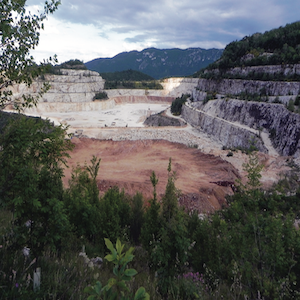Spontaneous renaturalization of open ecosystems in the hills of Brescia seen through the bird community

Accepted: 17 May 2023
All claims expressed in this article are solely those of the authors and do not necessarily represent those of their affiliated organizations, or those of the publisher, the editors and the reviewers. Any product that may be evaluated in this article or claim that may be made by its manufacturer is not guaranteed or endorsed by the publisher.
Authors
The sun-exposed open areas of the Brescia hills overlooking the Po Valley (Avanalpica region) were created by man starting from the 11th century. After the Second World War, following agro-pastoral abandonment, these areas have significantly shrunk. The evolution underway is towards the deciduous forest although in some areas the strong presence of quarries is blocking the vegetational succession or delaying it. Local birds are now largely associated with woodland coenosis and more scarcely with open areas, shrublands and wood edges. Seven open areas species have become extinct over the past 30 years: Woodchat Shrike, Barred Warbler, Rufous-tailed Rock-Thrush, Eastern Black-eared Wheatear, Tawny Pipit, Corn Bunting and Ortolan Bunting. Others, like Red-backed Shrike, Common Whitethroat, Cirl Bunting and Wood Lark have declined. Only the generalist Sardinian Warbler and Blue Rock-Thrush, typical of rocky areas with grassy spaces, are still relatively widespread although slightly decreasing. The Cirl Bunting, a species linked to traditional vineyards and orchards, is not expanding in the new intensively cultivated lands. The Eastern Subalpine Warbler is on the rise even though, due to its very low presence and lack of specific surveys, it may not have been detected in the past. The factors determining the presence of these species, i.e. traditional crops, flat open areas, soils with low grass and often with outcropping and/or rocky substrate, are in sharp decline. We can state that this bird community is negatively influenced by the percentage of tree cover and positively influenced by the presence of quarries which, however, represent an ephemeral and strongly impacting environment. In the absence of fires and/or natural disasters as well as human interventions, which are not likely to occur due to their poor economic sustainability, the prognosis for these birds is to be considered poor and a reduction in both bird and general biodiversity is to be expected.
Downloads
Citations
PlumX Metrics
PlumX Metrics provide insights into the ways people interact with individual pieces of research output (articles, conference proceedings, book chapters, and many more) in the online environment. Collectively known as PlumX Metrics, these metrics are divided into five categories to help make sense of the huge amounts of data involved and to enable analysis by comparing like with like.
How to Cite

This work is licensed under a Creative Commons Attribution-NonCommercial 4.0 International License.
PAGEPress has chosen to apply the Creative Commons Attribution NonCommercial 4.0 International License (CC BY-NC 4.0) to all manuscripts to be published.
Similar Articles
- Carlo Urbinati, Francesco Renzaglia, Andrea Bartolucci, Paolo Giacchini, Sustainable forest management and habitat of diurnal raptors in the SIC Alpe della Luna-Bocca Trabaria (province of Pesaro and Urbino). , Rivista Italiana di Ornitologia: Vol. 82 No. 1-2 (2012)
- Marco Pantalone, Riccardo Fama', Maurizio Saltarelli, Contributions and data regarding the Boreal Owl Aegolius funereus phenology in Marche region , Rivista Italiana di Ornitologia: Vol. 92 No. 2 (2022)
- David Pierre Milesi-Gaches, Feathered diplomacy: when birds become main factors of research design and geography on Vigur Island , Rivista Italiana di Ornitologia: Vol. 94 No. 1 (2024)
- Giorgio Marini, Paolo Forconi, Impact of lead shots on a mountain pass in central Apennines , Rivista Italiana di Ornitologia: Vol. 82 No. 1-2 (2012)
- Fabio Casale, Radames Bionda, Riccardo Falco, Paolo Siccardi, Valentina Toninelli, Diego Rubolini, Mattia Brambilla, Habitat management for Red–backed Shrike, Lanius collurio, conservation in farmland systems , Rivista Italiana di Ornitologia: Vol. 82 No. 1-2 (2012)
- Flavio Ferlini, Atlas of breeding birds of the European part of Russia , Rivista Italiana di Ornitologia: Vol. 91 No. 1 (2021)
- Stefano Sponza, Paolo Salvador, A new successful breeding site of Collared Pratincole Glareola pratincola along the northern Adriatic coastline , Rivista Italiana di Ornitologia: Vol. 93 No. 1 (2023)
- Guido Trivellini, Damiano Preatoni, Marco Cantini, Mauro Belardi, Andrea Agapito Ludovici, Guido Tosi, A quantitative approach to biodiversity estimation: application to birds in Alps Ecoregion - priority area H1 , Rivista Italiana di Ornitologia: Vol. 82 No. 1-2 (2012)
- Sandro Casali, Andrea Suzzi Valli, Distribution and density of diurnal and nocturnal birds of prey nesting in the Protected Naturalistic Area of Monte Titano (Republic of San Marino) , Rivista Italiana di Ornitologia: Vol. 82 No. 1-2 (2012)
- Maurizio Chiereghin, Alessandro Prezzi, Fabiano Sartirana, Update on successful nesting of bearded vulture (Gypaetus barbatus) in the Lanzo Valleys, Piedmont region (NW Italy) , Rivista Italiana di Ornitologia: Vol. 93 No. 2 (2023)
<< < 4 5 6 7 8 9 10 11 12 13 > >>
You may also start an advanced similarity search for this article.


 https://doi.org/10.4081/rio.2023.667
https://doi.org/10.4081/rio.2023.667



